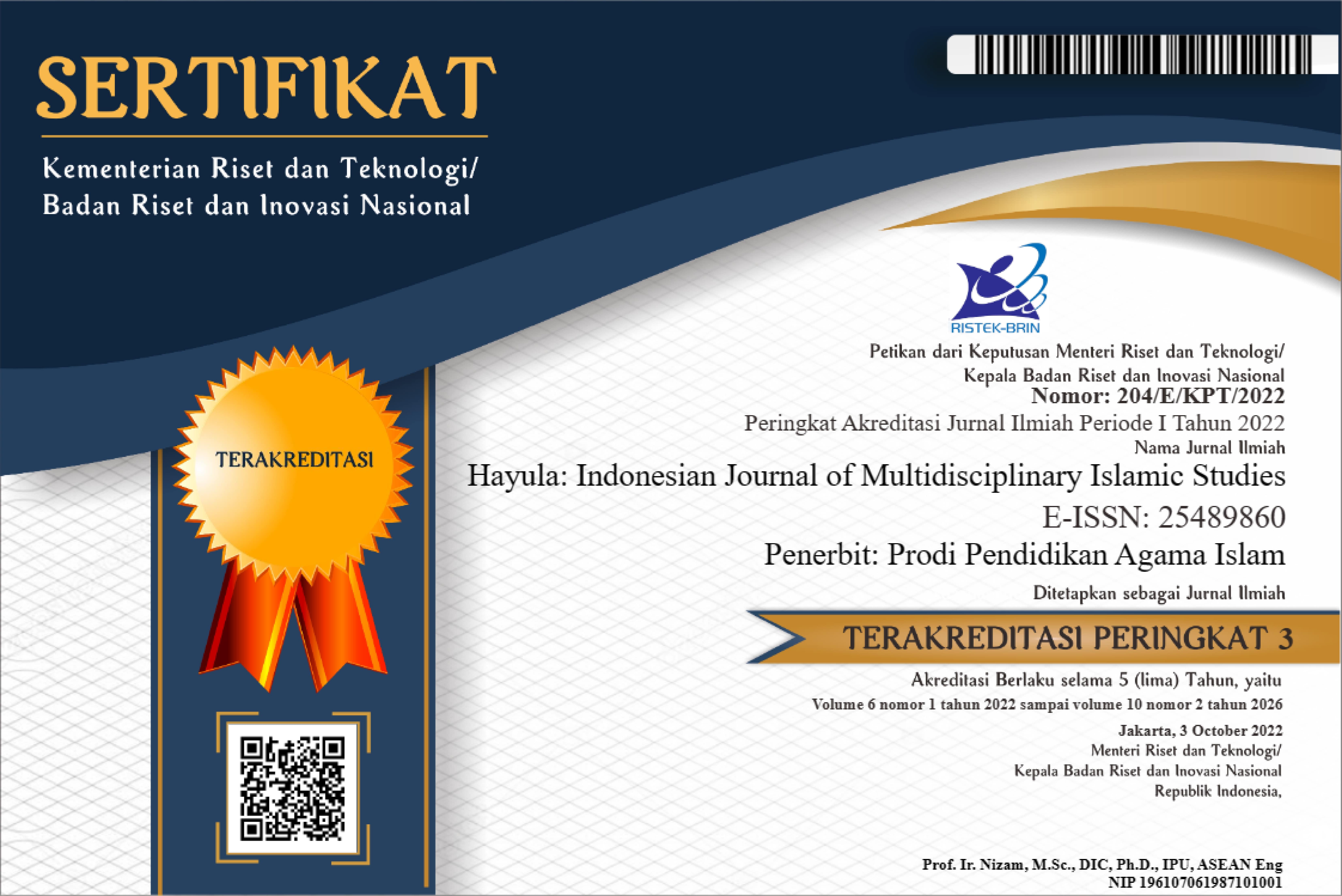Practice of Fetish-Badri in Healing a Possessed Among the People of Kala-Balge Local Government Area, Borno State, Nigeria: An Islamic Perspective
DOI:
https://doi.org/10.21009/hayula.002.2.04Keywords:
Badri fetish, possession, jinn, healingAbstract
This research work is centered on a Comparative Study of Badri-fetish in the light of Islam, with particular reference to Kala Balge. In this regard the role played by the populace in interaction with Badri fetish was examined. To this matter, the researchers used interview as instrument for data collection. So also Textbooks, Journals, Dissertations, Seminar papers were also included. The research found out that there are many kinds of traditional possession remedies in Borno according to different geo-political zones. It is interesting to note that Badri-fetish as a remedy has a link with supernatural forces. Badri-fetish is a healing process or ritual centered on the belief in the existence of the power of Jinn which possess their victims in various ways and forms. Therefore, the research found out that the rural dwellers are patronizing the aforementioned traditional remedy for the belief that all the practices involved are aimed at cure and healing. As such some of the fetishism practitioners have also regarded it as a means of entertainment and gain of worldly benefits. It is recommended that all sorts of healing methods should be considered provided they do not contravene to the teachings of Islam and if it may not harm or endanger the life of the people. To attain this it is recommended that whoever wants to engage in any permissible healing technique one must seek a deep knowledge in the field and to know the basic Islamic rulings in regards to his method, so as not to endanger the life of his clients.
References
Ahmad, A. (2009). Jinn Magic or Mental illness (in the Light of Holy Qur’an and Hadith Anjum Quadri. Jaisinghpura University Gate Aurangabal .
Alkali. (2012). Nigeria Research Network NRN’ Queen Elizabeth House. Oxford University.
Ash’ath. (n.d.). Sunan Abi- Dawud’ Daru Al-kitab Al-arabi. Beirut, Lebanon.
Ba’alabaki, R. (1995). Al-Maurid Al-Arabi: A Modern Arabic-English Dictionary’, . Beirut Lebanon: Dar El-Ilm Lilmalayin: 7th Edition.
Balogun. (2011). Syncretic Beliefs and Practices amongst Muslims in Lagos State with Special Reference to Yoruba Speaking People of Epe’ A thesis Submitted to the University of Birmingham school of Philosophy for PhD.
Borno state Government. (1993). Borno state Handbook’ Dadin-kowa ventures Jos Nigeria.
Cohen. (1967). The Kanuri of Bornu’ Winston Inc. New York.
Dahiru. (1986). Qur’anic Studies in Borno: Development in the Nineteenth and Twentieth Centuries . Maiduguri: Linform Services.
Dein, & Illaiee. (2013). Jinn and Mental Health: Looking at Jinn Possession in Modern Psychiatric Practice’ University College London. London: The Psychiatric Bulletin NHS Foundation Trust.
Dierk. (1990). Ethno geneses from within Chadic State some Thoughts on the History of Kanem Borno. Presented at International Conference of Historical Sciences. Madrid.
Isma’il. (1987). Al-jami Al-sahih’ Darul Shu’aib Cairo.
Kaka. (2009). An Auto-Ethnographical Study of Integration of Kanuri Traditional Health Practices into the Borno State Health Care System. PhD theses Durham University.
Kala, A. B. (2016, June 20). interviewed at Custom Area. (Farmer, Interviewer) Maiduguri Town, Borno State.
Khalid. (2010). The Preservation of Arabic ‘Spiritual Medicine’ in Hausa Society’ Arabic/Ajami manuscripts. Resource for the Development of New Knowledge in Nigeria,Arewa House. Nigeria: Centre for Historical Documentation and Research A.B.U Zaria Kaduna.
Lawan Mai Sigalma, (. Y. (2016, July 26). interviewed at Internally Displaced Persons Camp, . Camp Ngala Road. (C. Priest, Interviewer) Maiduguri, Borno State.
Ma’rouf. (2003). Tahzeebu Dalilu Al-faliheen, Sharh Riyadh Al-salihin The Meadows of the righteous’ Dar-Al- manara El-Mansoura Egypt. Egypt.
Makinta, Z. (2016, August 2). interviewed in Internally Displaced Persons Camp. (Tailor, Interviewer) Bama Road. Maiduguri.
Mayomi., & M. J. (2014). A Decade Assessments of Maiduguri Urban Expansion (2002-2012). Global Journals Inc. (USA), 14.
Muhammad. (2004). Al-Ruqyah Al-Shar’iyyah’ 2009 2nd Ed Daru Al-kutub Al-Ilmiyyah. Beirut.
Philip A. B. (1989). The Fundamentals of Tauheed’ Al-hidaya U.K. U.K.
Rann, B. (2016, July 26). interviewed at Army Children Internally Displaced Persons Camp. (C. Priest, Interviewer) Borno State, Maiduguri.
Sediq. (2010). ‘The Delusion by the Satan’ Ibn Al-Jauzi. Egypt: Dar Almanar.
Sifawa. (1991). The Role of Kanem Borno Ulama in the Intellectual Development of the Bilad Al-Sudan’ A paper presented at a conference organized. the centre for Transaharan studies University of Maiduguri.
Tijjani. (2005). Tradition and Modernity the Gamergu (Malgwa) of Northern-Eastern Nigeria. In P. T. London. London.
Tijjani. (2008). Malamih Anil Ulama’I fi Borno Abari Usuriha Al-Tarikhiyyah’ Al-Arabiyyah. Journal of Arabic Culture National Arabic Language Village.
Usman H.M, John , & Usman H. (2011). Contributions of Seasonal Migrants’ Fishermen towards fishing activities in Baga, Kukawa Local Government of Borno State. Journal of Environmental issues and Agriculture in Developing Countries, 2.
www.cometonigeria.com , . (n.d.).
Downloads
Published
How to Cite
Issue
Section
License
Authors who publish with this Journal agree to the following terms:
- Author retain copyright and grant the journal right of first publication with the work simultaneously licensed under a creative commons attribution licensethat allow others to share the work within an acknowledgement of the work’s authorship and initial publication of this journal.
- Authors are able to enter into separate, additional contractual arrangementfor the non-exclusive distribution of the journal’s published version of the work (e.g. acknowledgement of its initial publication in this journal).
- Authors are permitted and encouraged to post their work online(e.g. in institutional repositories or on their websites) prior to and during the submission process, as it can lead to productive exchanges, as well as earlier and greater citation of published works.
Users/public use of this website will be licensed to CC BY






